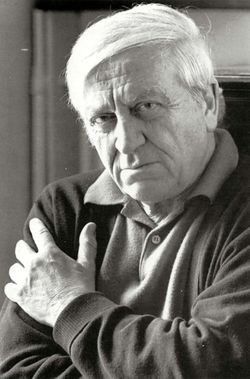Ohana, Maurice
Biography
Born: June 12, 1914 Casablanca
Died: November 13, 1992 Paris, France
Country: France
Studies: French School, Sorbonne, Schola Cantorum, Accademia di S Cecilia
Teachers: Daniel Lesur, Alfredo Cassella
Website: http://www.mauriceohana.com/
Born on June 12, 1913 in Casablanca, Maurice Ohana did almost all his musical studies in France, while pursuing his classical studies. He moved for some time towards the architecture he abandoned to devote himself entirely to music.
Very young, he began as a pianist in the Basque Country where his family is fixed; his career remains promising until the war that will take him away from the musical world, but also bring him back to Rome where he is the pupil and friend of Alfredo Casella at the Académie Sainte-Cécile.
Once demobilized, he settled again in Paris in 1946. It was at this time that his first works were known in France. He founded, with three friends, the "Zodiac Group", which proposes to defend the freedom of expression against the dictatorial aesthetics then in vogue. And to this day, he continues to embrace the manifesto of his youthful struggles.
Deep constants appear in his work. From Llanto por Ignacio Sanchez Mejias (1950) to recent works, evolution tends to a rigor curiously associated with a great freedom of pace, both in writing and in relations with the interpreter. Resolutely apart from the twelve-tone or serial movements, Maurice Ohana has nonetheless continued a revolution in the expansion of methods and the exploration of sound and the forms that result.
Maurice Ohana on foot Faithful to its Andalusian origins, while expanding their musical essence to universal dimensions, Maurice Ohana has progressed towards a synthesis where we find the research and the concerns of the current music. First of all, with regard to the range that it frees from the diatonic straitjacket, the rhythm it tends to free from the bar of measurement, and the vocal techniques that it brings back to their original virtues, out of the grip bel canto.
Pianist from his childhood, he has retained a predilection for this instrument, but has also enriched various instrumental areas, including percussion, with works such as the Silenciaire, the Quatre Études becoming a classic, pieces for the new guitar ten strings, or vocal works such as The Office of Oracles for three vocal and instrumental groups, Cree for twelve voices or Sibyl, for voice, percussion and band, which reveal a resolutely innovative temperament in all sound domains.
From 1976, an uninterrupted series of large-scale works such as The Ring of the Tamarit for cello and orchestra, The Mass, The Three Tales of the Honorable Fleur, chamber opera, The Book of Prodigies, for large orchestra , Twelve studies for piano, etc ... lead to the sum that is the opera La Celestine created June 13, 1988 at the Palais Garnier with the success that we know.
Other works for choir and also for orchestra will follow, like the concerto for cello and orchestra created by M. Rostropovitch and S. Osawa, affirming an exceptional vitality which did not seem to have to dry up. The last born, Avoaha, for chorus, two pianos and three percussions, testifies to it.
Maurice Ohana - Portrait Maurice Ohana has never practiced teaching and has no students; However, it can be located at the center of a group of young composers from various backgrounds whose work it has long followed and whose orientation, in affinity with his own, constitutes a confirmation of the validity of his original options. . Among them are Félix Ibarrondo, Ton-That Tiêt, Edith Canat of Chizy, Francis Bayer, André Bon, Guy Reibel and Nicolas Zourabichvili of Pelken.
Maurice Ohana received the Prix Italia in 1969, the National Music Prize in 1975, the Honegger Prize in 1982, the Musical Prize of the City of Paris in 1983, and, in 1985, the Maurice Ravel Prize. In 1991, he was laureate of the Grand Prix of Guerlain Music of the Academy of Fine Arts. In 1992, he received the SACEM Prize for the best first performance in 1991.
Since 1990 he has been President of the Maurice Ravel International Academy in St-Jean-de-Luz. He was Knight of the Legion of Honor and Commander of Arts and Letters.
Maurice Ohana died on November 13, 1992 at his Paris home.[1]
Works for Percussion
Etudes Choregraphiques - Percussion Quartet
Etudes d'Interprétation XI et XII - Multiple Percussion; Piano
Miroir de Célestine - Multiple Percussion; Harpsichord
Sibylle - Multiple Percussion; Voice; with Tape
Silenciare - Percussion Sextet; Orchestra
Trois Prophéties de la Sibylle - Multiple Percussion; Voice; Piano
References
